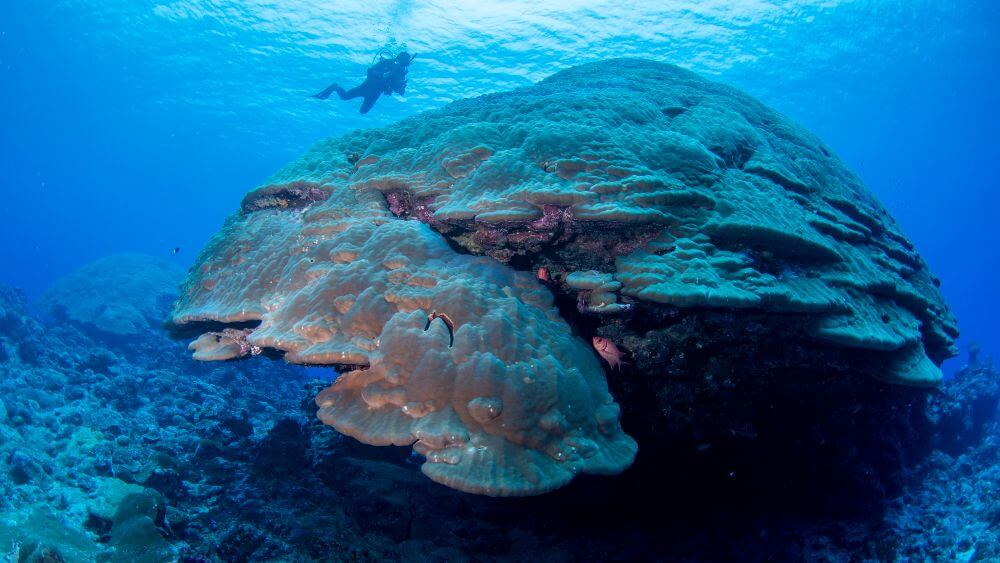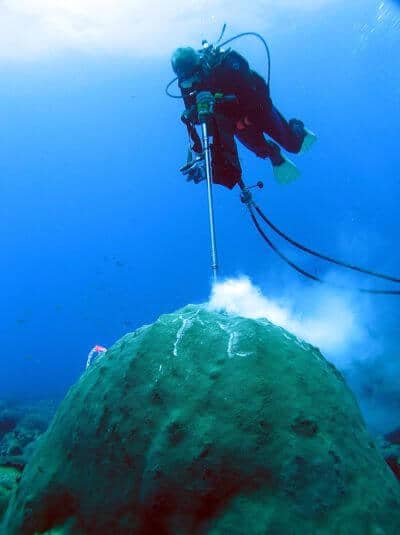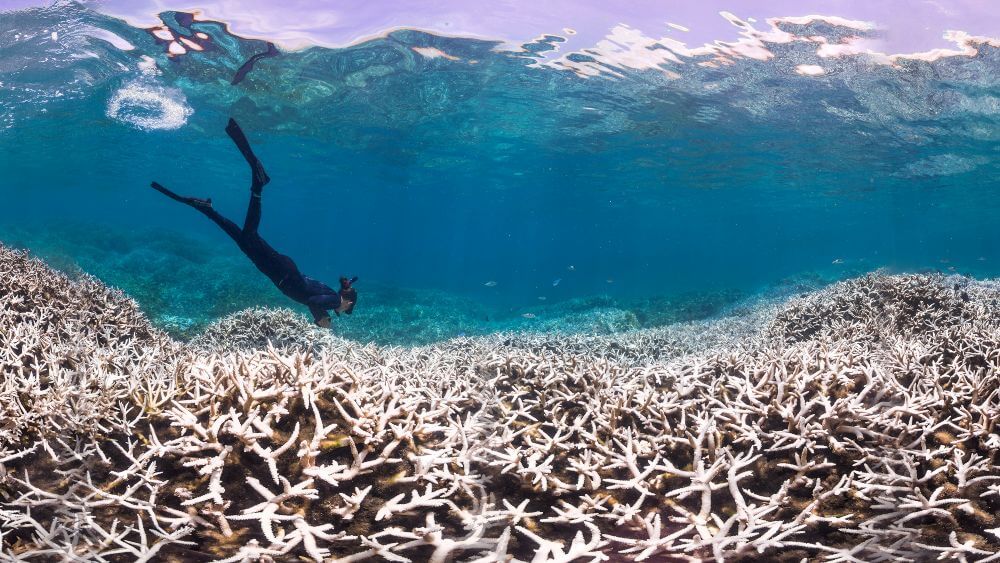This living marine laboratory provides a better understanding of coral biology and may unlock secrets to how corals cope with changing ocean conditions.
A Remote Journey
As the first golden light emerges above the horizon of Tutuila Island, a small team of NOAA scientists and coral specialists make final checks over technical equipment and dive gear. Their small boat undergoes a safety inspection and is fueled for an open-water voyage. The motor purrs to life, breaking the silence of the morning, and the crew leaves the flat water of Tutuila behind.
The vessel darts across the expansive sea for more than four hours before reaching the targeted coordinates. The island of Ta’u lies over fifty miles to the east of the main island of Tutuila. The water within this unit of National Marine Sanctuary of American Samoa is glassy and crystalline blue. The team cuts the engine and readies their scuba gear before slipping into the still water.
Visiting a Giant
It isn’t long before the divers spot a large mound rising from the ocean floor. This giant lifeform, shaped like an oversized mushroom cap, has rested beneath the waves for hundreds of years. Once considered to be the largest coral in the world, Big Momma is one of several massive Porites corals living within the boundaries of National Marine Sanctuary of American Samoa and the National Park of American Samoa. This area has a high density of large Porites colonies and has been nicknamed the “Valley of the Giants.”

Giant Porites corals tower over the rest of the reef within the Valley of the Giants. (Image credit: Matt McIntosh/NOAA)
Big Momma’s vast dome casts a shadow that swallows the sunlight as the divers descend towards the seabed to make their approach. Communications and outreach coordinator for the sanctuary, Nerelle Que Moffitt, says that being in the presence of the gargantuan coral “makes you drop your jaw and say, ‘I can’t believe this is real’.” Like doctors evaluating a patient, the team spends the next hour making several close passes looking for any signs of distress or ailment.
The divers look miniaturized as they hover over the textured coral that is as tall as a two-story house and the width of a tennis court. The team makes direct observations and collects video and photographic evidence for further evaluation back on dry land. They take note of a few growth anomalies, and notice areas where coral tissue is missing due to bites from hungry pufferfish. Thankfully, there are no signs of major physical damage and no visible indicators of other coral diseases. Big Momma is in good shape—despite a bleaching event due to warmer water temperatures that affected other corals within the area in 2020.
Learning from the Layers
Another group of scientists carefully removed a core sample from Big Momma in 2011 that helped to uncover some of the coral’s secrets. They evaluated growth patterns similar to tree rings to determine the coral was roughly 500 years old. “This is a very old coral and it opens a window into historic conditions in Ta’u,” said Val Brown, research coordinator for National Marine Sanctuary of American Samoa.
Oxygen is one of the best ways to learn about past climates. Oxygen comes in heavy or light varieties (or isotopes) and these molecules get left behind in layers of the coral core. The ratio of oxygen isotopes changes with temperature and could be used like a historical thermometer to peer into the water chemistry of the past. The data led researchers to conclude that where Big Momma sits may be a naturally protected zone. Weather patterns that alter sea surface temperature and other chemistries appear to have less of an effect near Ta’u. The Valley of the Giants lies within an El Niño Southern Oscillation (ENSO) null zone and its natural shielding from temperature fluctuations may be why corals here can become so massive and long-lived.
 In order to see these layers, scientists drill cores out of large coral heads, like this Orbicella faveolata in Flower Garden Banks National Marine Sanctuary. Extracting a core allows them to look at many years-worth of layers in one compact unit. The larger the coral colony, the more years of data they can extract. (Image credit: NOAA)
In order to see these layers, scientists drill cores out of large coral heads, like this Orbicella faveolata in Flower Garden Banks National Marine Sanctuary. Extracting a core allows them to look at many years-worth of layers in one compact unit. The larger the coral colony, the more years of data they can extract. (Image credit: NOAA)
A Culture of Conservation
The Samoan culture is one of the oldest in Polynesia extending back thousands of years. Throughout this time, Samoans have found ways to thrive with limited resources and developed a vibrant society that values tradition and family. They understand the importance of living in connection with nature and their reliance on the surrounding ecosystem for food and livelihood. The awareness of the Valley of the Giants is relatively new in the scientific community, but Samoans have known about these spectacular corals for generations. Through their balanced and communal lifestyle, called Fa’a Samoa, they have played an integral part in safeguarding the local marine ecosystem.
A Living Laboratory
Much like the Samoan people that inhabit this special place, ecosystems here are strong and resilient. Reefs across the entire territory of American Samoa have been found to be more tolerant of higher temperatures that have caused coral reefs in other parts of the world to go through severe bleaching events and die offs. These rich waters serve as a living laboratory, where NOAA scientists can study and monitor the health of a diversity of reef life. They remotely evaluate water chemistry and carbon dioxide levels, and search for understanding of why corals here are so hardy.
 While corals within and around National Marine Sanctuary of American Samoa are resilient and healthy overall—especially those near Ta’u and in the Valley of Giants—they are still susceptible to impacts from climate change. Thickets of branching corals shown here bleached during a warm period in 2015. (Image credit: XL Catlin Seaview Survey)
While corals within and around National Marine Sanctuary of American Samoa are resilient and healthy overall—especially those near Ta’u and in the Valley of Giants—they are still susceptible to impacts from climate change. Thickets of branching corals shown here bleached during a warm period in 2015. (Image credit: XL Catlin Seaview Survey)
Though they are nearly 5,000 miles west of the US mainland, the scientists are also aware that these rich, thriving reefs with colossal corals are not immune to the impacts of human action and a changing ocean climate. A recent condition report from National Marine Sanctuary of American Samoa outlines that while the area is healthier than many other ocean ecosystems, it still faces challenges. Rising water temperatures due to climate change have caused coral bleaching events and the abundance of some marine species is diminishing due to human impacts. NOAA scientists hope to annually monitor corals like Big Momma. They are looking into using technologies like 3D mapping to study changes in volume over time and underwater sound recorders to monitor fish, marine mammal, and vessel sounds. Continued conservation and understanding of these unique habitats will be key to their future resilience.
 A monitoring buoy in Fagatele Bay collects data on carbon dioxide from surface seawater and the atmosphere as well as data on water temperature, salinity, pH, oxygen, and chlorophyll. (Image credit: Nerelle Que Moffitt/NOAA)
A monitoring buoy in Fagatele Bay collects data on carbon dioxide from surface seawater and the atmosphere as well as data on water temperature, salinity, pH, oxygen, and chlorophyll. (Image credit: Nerelle Que Moffitt/NOAA)
A Coral Community
Brown has seen a spectacular diversity of life around the Porites coral on her scientific dives. “It definitely takes my breath away every time I drop into the site,” says Brown. According to Brown, spiny lobsters and schools of fish like snappers and sweepers hide under Big Momma’s ledges. Sea turtles glide by the boulder-sized coral while large parrotfish and dazzling sweetlips forage nearby. Even in areas where Big Momma has suffered tissue damage, branching Pocillopora and Acropora corals have settled, providing protection for clouds of damselfish to hide from predators.
 The real estate market is highly competitive on a coral reef. Hard and soft corals, sponges, hydroids, algae, and more, all compete for a prime location. When parts of large corals like Big Momma die, sometimes another coral finds an open spot to build its home. (Image credit: Wendy Cover/NOAA)
The real estate market is highly competitive on a coral reef. Hard and soft corals, sponges, hydroids, algae, and more, all compete for a prime location. When parts of large corals like Big Momma die, sometimes another coral finds an open spot to build its home. (Image credit: Wendy Cover/NOAA)
Big Momma took hundreds of years to grow to its current size, but the managed conservation of the Valley of the Giants and National Marine Sanctuary of American Samoa has grown exponentially in just a small amount of time. Though it started as the smallest, the sanctuary was expanded and is currently the largest in the US National Marine Sanctuary System covering more than 13,500 square miles of sparkling ocean.
Continued protection and long-term monitoring of this remote marine ecosystem will help scientists better understand how corals respond to the stresses of a changing ocean climate and may unlock solutions to conservation and preservation techniques to mitigate human impacts on these environments. This information is especially important as practitioners race against the clock to respond to multiple issues, like coral bleaching and coral diseases, in places like Florida Keys National Marine Sanctuary and throughout the Caribbean.

